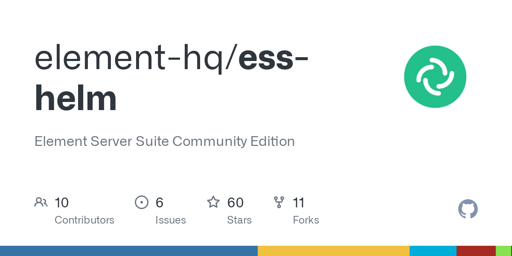So this is a pretty big deal to me (it looks recent, just put up last October). One of my big frustrations with Matrix was that they didn’t offer helm charts for a kubernetes deployment, which makes it difficult for entities like nonprofits and community clubs to use it for their own purposes. Those entities need more hardware than an individual self hoster, and may want features like high availability, and kubernetes makes horizontal scaling and high availability easy.
Now, according to the site, many of these features seem to be “enterprise only” — but it’s very strangely worded. I can’t find anything that explicitly states these features aren’t in the fully FOSS self hosted version of matrix-stack, and instead they seem to be only advertised as features of the enterprise version
My understanding of Kubernetes architecture is that it’s difficult for people to not do high availability, which is why this makes me wonder.
Looking through the docs for the "enterprise version, it doesn’t look like anything really stops me from doing this with the community addition.
They do claim to have rewritten synapse in rust though
Being built in Rust allows server workers to use multiple CPU cores for superior performance. It is fully Kubernetes-compatible, enabling scaling and resource allocation. By implementing shared data caches, Synapse Pro also significantly reduces RAM footprint and server costs. Compared to the community version of Synapse, it’s at least 5x smaller for huge deployments.
And this part does not seem to be open source (unless it’s rebranded conduit, but conduit doesn’t seem to support the newer Matrix Authentication Service.)
So, it looks Matrix/Element has recently become simultaneously much more open source, but also more opaque.
If you don’t have a hard requirement for the Helm Chart to be written by Element themselves, I’ve been maintaining some Charts for Matrix components for almost six years - which have also ended up being used as the base for the German BundesMessenger project. Unfortunately free time hasn’t allowed me to do nearly as much as I want with it, especially since it continues to work for the use-cases for my job.
We do have a room on Matrix for dealing with Kubernetes setups though.
I also ended up chatting with one of the core devs of Synapse about ways to improve regular Python Synapse for use with Kubernetes back in the ending of January, so hopefully it’ll improve in that direction when time allows. They have the exact same problems with providing hosted setups after all, so they too want to make the open-source version easier to run.
Hello Ananace! :)
I actually have seen your helm charts many, many times before when searching for matrix, synapse, or lemmy on Artifacthub.
An official helm chart isn’t really a hard requirement to me, even if I were to use one and it were to stop getting maintained, I could continue on my own. But an official helm chart has big community benefits that are very important to me. Like, there becomes the option of paid support, which is a must have for many entities. Also, an official organization may support a wider variety of usecases than someone making helm charts for personal use.
I also ended up chatting with one of the core devs of Synapse about ways to improve regular Python Synapse for use with Kubernetes back in the ending of January, so hopefully it’ll improve in that direction when time allows
Do you know anything about the claims that they have rewritten synapse in rust?
It’s worth noting that the ESS suite Chart is absolutely not built to be community-viable, it’s built for the kind of single-purpose deployments that Element offer hosting for, and it also breaks almost all Kubernetes best practices. Which is actually not wrong per-se. Element need to be able to maintain it after all, and since they don’t have the Kubernetes know-how to build generic components, it makes sense to instead bundle a fully integrated solution which they are comfortable with developing and debugging.
They’re definitely slowly but steadily rewriting Synapse in Rust as well, that’s been an open and ongoing project for a while now. You can see that just by looking in the Rust folder in the Synapse sources.
I strongly doubt that they have the “rest” of the application rewritten internally and keeping it hostage for paid hosting though, it’d cost them too much to keep separate codebases for such a thing.The “Synapse Pro” offering is most likely just the regular Python+Rust Synapse, but with a few additional HA components and some workers written in Rust for efficiency, just like how there’s community workers written in both C# and Go for performance reasons.
Even without ess or this helm chart, lots of ppl can still run matrix in k8s. But it’s good to see them to release more open source code. Thx for the news.
This helm chart is not just matrix/synapse, but also element (web ui), and “matrix authentication service”, which adds SSO/OIDC support to a normal synapse instance, which is pretty neat. I haven’t seen any helm charts that include the full matrix stack, just separate synapse or element helm charts. And helm definitely makes deploying services to Kubernetes easier than other ways of deploying applications.
The other reason why I like an official helm chart, is because I have seen unofficial one’s be stopped being maintained by the community member(s) maintaining them. With an official one, it will (probably) be maintained indefinitely.
Right, but you could have just made one yourself. They’re not hard to maintain. It’s just a pile of yaml
Right, but you could have just made one yourself
And then there would be a bus factor of one. It’s not just about making a helm chart for myself, it’s about having something that can be shared with the community, that doesn’t depend on any single person to be maintained and updated.
It’s about having an organization that provides “packages” for Kubernetes, for people/orgs that don’t have the time, expertise, and energy to maintain them.
I greatly respect Ananace, who is in the comments of this post, and mentioned their Helm charts. The work is excellent. But looking through the commits, it’s just one person, doing something that primarily consists of bumping version numbers. Contrast this to the Matrix ESS helm chart, where the commits consist of many more contributors, and also include feature additions to the helm chart.
Ppl actually moved away from helm because lots of small helm chart is abandoned. And lots of ppl’s matrix already integrated with oidc. I prefer desktop app and mobile app. Haven’t looked into web ui. The real problem for matrix is the bridges: support is minimal, lots of trial and err; code is in beta, make me worried.
Is there a dumb-proof installer to run a matrix server in an offline LAN party?
Is Kubernetes so pervassive that a helm chart unlocks that many more entities?
Yes and no. There are many things that are much easier with Kubernetes, once you figure Kubernetes out.
High availability is the most notable example — yes, it’s doable in docker, via something like swarm, but it’s more difficult. In comparison, the ideas of clustering and working with more than one server are central to the architecture of Kubernetes.
Another thing is that long term deployments with Kubernetes can be more maintainable, since everything is just yaml files and version is just a number. If you store your config in code, then it’s easier to replicate it to another server, either internally, or if you share it for other people to use (Helm is somewhat like this).




